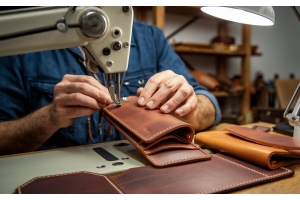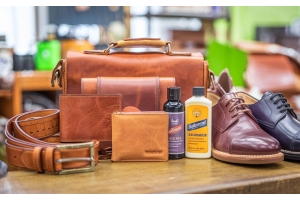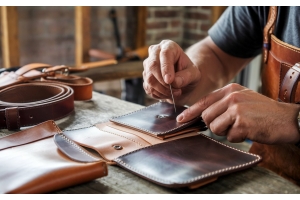Sustainable Leather: How Real Leather Supports Eco-Friendly Practices

Sustainable Leather: How Real Leather Supports Eco-Friendly Practices
In recent years, sustainability has become a major focus across various industries, with consumers increasingly demanding products that are not only high quality but also environmentally friendly. Among these products, leather, traditionally seen as a luxury material, is now being scrutinized for its environmental impact. However, when sourced and processed sustainably, real leather can actually play a significant role in supporting eco-friendly practices. In this extensive blog post, we will delve into the environmental benefits of using sustainably sourced leather, and why choosing real leather can be a conscious, eco-friendly decision.
Understanding Sustainable Leather
Sustainable leather refers to leather that is produced with a reduced environmental footprint, considering the entire lifecycle of the product—from the sourcing of raw materials to the manufacturing processes and eventual disposal. Sustainable leather is typically sourced from farms and tanneries that follow environmentally responsible practices, which include ethical animal husbandry, efficient use of resources, and minimizing the release of harmful chemicals into the environment.
The Environmental Benefits of Sustainably Sourced Leather
1. Utilization of a Renewable Resource
Leather is a natural material, derived from the hides of animals, which are by-products of the meat and dairy industries. Rather than letting these hides go to waste, they are repurposed into leather goods. This efficient use of resources reduces waste and makes leather a renewable resource. In contrast, synthetic leathers, often made from petroleum-based materials, rely on non-renewable resources, contributing to the depletion of fossil fuels.
2. Biodegradability
One of the most significant environmental benefits of real leather is its biodegradability. Unlike synthetic alternatives, which can take centuries to break down, real leather decomposes naturally over time, especially if it is tanned using vegetable-based methods. This means that at the end of its life cycle, leather does not contribute to the growing problem of plastic pollution.
3. Longevity and Durability
Sustainably sourced leather is known for its longevity and durability, making it a sustainable choice for consumers. High-quality leather products can last for decades, reducing the need for frequent replacements. This longevity directly reduces the demand for new resources and the energy required to produce new products. In a world where fast fashion contributes significantly to environmental degradation, investing in durable leather goods is a step toward a more sustainable lifestyle.
4. Reduced Chemical Use
Modern sustainable tanning processes aim to minimize the use of harmful chemicals, such as chromium, which are traditionally used in leather production. Vegetable tanning, for instance, uses natural tannins found in plants, which are not only safer for the environment but also for the workers involved in the tanning process. This shift towards eco-friendly tanning methods reduces the pollution of water bodies and soil, contributing to a healthier ecosystem.
5. Support for Ethical Farming Practices
Sustainable leather sourcing often goes hand-in-hand with ethical animal farming practices. Farms that supply hides for sustainable leather production typically follow humane practices, ensuring the well-being of animals. These farms also focus on regenerative agriculture techniques, which restore soil health, enhance biodiversity, and capture carbon dioxide from the atmosphere. By supporting sustainable leather, consumers indirectly support these environmentally beneficial farming practices.
6. Energy Efficiency in Production
The leather industry has made significant strides in reducing its carbon footprint by adopting energy-efficient practices. Many tanneries now use renewable energy sources, such as solar or wind power, to fuel their operations. Additionally, advancements in technology have led to more efficient use of water and energy in the leather manufacturing process, further reducing its environmental impact.
The Importance of Certified Sustainable Leather
To ensure that the leather you purchase is truly sustainable, it is crucial to look for certifications from recognized organizations. Certifications like the Leather Working Group (LWG) and the Global Organic Textile Standard (GOTS) provide assurance that the leather has been produced following strict environmental and social criteria. These certifications evaluate factors such as waste management, energy use, and chemical safety, ensuring that the leather meets high sustainability standards.
Sustainable Leather vs. Synthetic Alternatives
While synthetic leather, often marketed as "vegan leather," may seem like an eco-friendly choice, it often falls short in terms of sustainability. Most synthetic leathers are made from plastic-based materials like polyurethane (PU) or polyvinyl chloride (PVC), which are derived from fossil fuels and are non-biodegradable. The production of these materials can release toxic chemicals into the environment, and their disposal contributes to the growing issue of plastic waste.
In contrast, sustainably sourced real leather offers a more environmentally friendly alternative, particularly when it comes to biodegradability and resource efficiency. Additionally, real leather's longevity reduces the need for frequent replacements, making it a more sustainable option in the long run.
Conclusion: Making a Conscious Choice for the Planet
Sustainable leather represents a harmonious blend of luxury and environmental responsibility. By choosing real leather that is sourced and produced sustainably, consumers can enjoy high-quality products while also supporting eco-friendly practices. The environmental benefits of sustainable leather—such as biodegradability, resource efficiency, reduced chemical use, and support for ethical farming—make it a compelling choice for those looking to minimize their environmental impact.
As the demand for sustainable products continues to grow, it is essential for consumers to educate themselves about the benefits of sustainable leather and make informed purchasing decisions. By doing so, we can collectively contribute to a more sustainable and eco-friendly future.





